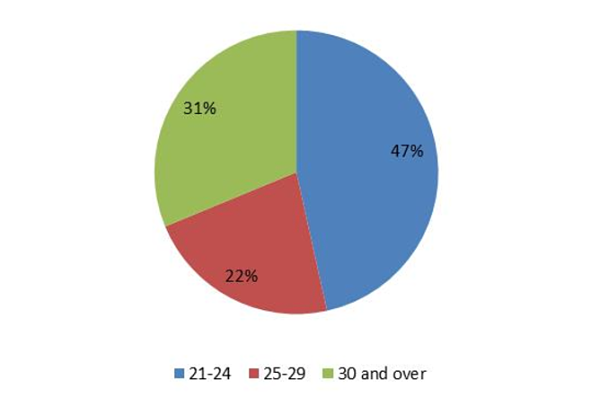 News
News In the UK, Are Student Populations Growing Older?
Halls full of 18-year-old freshers running riot? Bragging tales of gap year misadventure? Older students starting a university course can sometimes find it hard to fit in. But a growing number of mature students are now applying to study at university. But who are they, and what does this rising trend in applications mean for universities?
According to the Universities and Colleges Admissions Service, 2014 has seen the continuation of a small but steady annual increase in application rates to university from people older than 21.

This article by Jill Johnes originally appeared at The Conversation, a Social Science Space partner site, under the title “Hard Evidence: are more older people going to university?”
Around a third of UK-domiciled first degree entrants are mature students. This proportion has remained reasonably constant over the last decade.

Percent of first year first degree UK-domiciled undergraduate students (full and part-time) by age (Source: HESA, Students in Higher Education Institutions, author provided)
It is somewhat remarkable given the changes observed in the higher education sector over the same period, in particular rising fees and the lifting of the cap on the numbers of students with good A level grades that universities can admit. The latter change is most likely to attract extra young entrants with traditional entry qualifications, thus putting downward pressure on the proportion of mature students in the overall student body.
Student composition and background
Published data on the whole mature student population across all UK universities is difficult to find. But we can piece together a picture of a group of students who differ from their younger counterparts in terms of socio-economic background and university experience.
Mature students cover a wide age range. In 2012-13, 34 percent of mature students staring a new course were in the 21-24 age range, compared with 22 percent in the 25-29 group and 43 percent in the oldest category of 30 and older.
But these figures conceal a large difference in the age composition of full-time and part-time students. There are fewer older full-students (see first pie chart) than there are part-time students (second pie chart). Much of the published data comparing mature and young students refers only to full-time students.

Percent of full-time mature first year undergraduates by age (Source: HESA, Students in Higher Education Institutions, Table H 2012/13, author provided)

Percent of part-time mature first year undergraduates by age (Source: HESA, Students in Higher Education Institutions, Table H 2012/13, author provided)
Experience at university
Mature students are more likely to study on a part-time basis than young students: in 2012-13, 91.5 percent of part-time first degree entrants were mature, while only 21.1 percent of those starting full-time courses were mature students. They also choose different subjects compared to their young colleagues.
In particular, the percentage of mature entrants taking studies allied to medicine (which includes nursing) is considerably larger than younger students. Smaller differences can be seen in education and computer sciences. In contrast, the sciences (biological, physical and mathematical) and history and creative arts attract smaller percentages of mature students.

Subject of entrants to full-time first degree courses, 2012-13 (Source: HESA, UKPIs: Widening participation of under-represented groups, tables SP2 and SP3, 2012/13, author provided)
Mature students are also less likely than young students to study at an older, pre-1992 university. The lead taken by the new universities in attracting mature students may be a consequence of the broad range of courses on offer. These might be particularly attractive to students with non-traditional entry qualifications.

Full-time first degree entrants by type of university, 2012-13 (Source: HESA, author provided)
Higher drop-out rates
What then are the challenges to universities presented by mature students? Early research has suggested that older students may be less likely to complete their course than young students, although this result can vary by subject or by gender.
An examination of recent data suggests that the non-continuation rate at university is certainly much higher among mature students than younger ones, but in both cases the rate has fallen in recent years, and more rapidly among mature students.

Percent of students not completing their first academic year (Source: HESA, author provided)
HESA, Author provided
Returning to education is likely to cause challenges for mature students: picking up studies after a break, integrating with young students with different life experiences, and coping with financial problems are just a few of the difficulties. Universities should be aware of this and offer the support to maintain their participation in higher education.
But for those who do stay the course, higher education can prove to be a highly positive experience: 58% of those aged 25 and older were in full-time employment within six months of graduation, compared with 55% of those aged 24 and under. This small difference in full-time employment between mature and young first degree graduates has persisted for the past six years.
The diverse backgrounds of mature students contribute to the richness of university life. This fits with the government’s push to extend the opportunities of university education to more people.![]()























































































